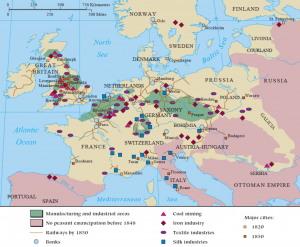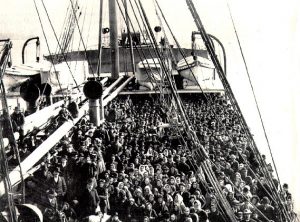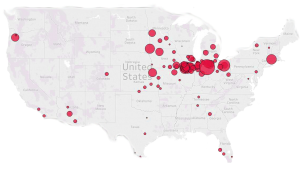WHO ARE APOSTOLICS
In this study, the terms “Apostolic”, “Apostolic Christian”, and “Apostolic Church” refers to a group of Christian believers of the Apostolic Christian Church of America. This church, founded in the early 1830s by Samuel H. Froehlich in Switzerland, is deeply rooted in religious conviction and devotion. Church worship and member lifestyles emphasize order, simplicity, and humility as a means of personal devotion and a reflection of reverence for God.1
Samuel Heinrich Froehlich
Samuel Froehlich is the father of the Apostolic Christian Church. After a dramatic conversion of faith, Froehlich (1803-1857), willingly abdicated his ordination in the ministry of the Protestant State Church and began spreading his message of repentance and conversion throughout Europe. Many of Froehlich’s teachings aligned closely with the Anabapist movement known as the “Old Baptists” or Mennonites. Soon after, Froehlich’s followers became known as the “New Baptists” and eventually adopted the name “Evangelical Baptists.”2
Froehlich’s personal diaries and writings express the internal conviction and conflict he faced in his conversion. His experience is important because it demonstrates the process many Apostolic’s undergo in their own conversions and demonstrates the justification for which they incorporate faith in every aspect of their lives.3
MIGRATION HISTORY
After being jailed for holding meetings practicing his faith,
Andrew J. Braun of Schweinfort was “told by authorities that his congregation had the choice of giving up their faith or emigrating.”
July 2, 1854 – Braun, along with his family and his entire congregation, landed in Peoria, Illinois.4
“Do violence to no man…” Luke 3:14 KJV

Many Apostolics were enticed by America’s vast expanses of available and cheap farmland throughout the Upper Mississippi Valley.
The arrival of the Apostolic faith to America in 1847 was provoked by a number of environmental, economic, cultural, and political factors. Conflict between Apostolic beliefs and the wars and whims of European governments forced many Apostolics to flee their homelands of Switzerland and Germany in order to avoid forced military service and religious persecution.5 Additional factors including, America Calling, Swiss Migration, and German Migration also played a significant role in Apostolic migration.
AMERICA CALLING
Weyeneth and the Amish Mennonite
In 1847, ordained elder Benedict Weyeneth, under Samuel Froehlich, was summoned to Lewis County, New York by Amish Mennonite, Joseph Virkler, to mitigate in spiritual conflicts within their group of believers. Weyeneth was so favored in the congregation that many members began leaving the Amish Mennonite Church in order to follow Froehlich’s teachings.6 The first churches of the Apostolic Christian faith in the United States were formed in 1850 in Croghan and Naumburg, New York.7
Croghan and Naumburg
In 1848, while the churches in Croghan and Naumburg were being established, a number of newly immigrated Swiss and German believers began making their way inland, via the Ohio River to a newly founded settlement in Sardis, Ohio. Like many early settlers, Apostolics used inland waterways to spread out across the Midwest. From Sardis, families made their way up the Ohio River to the Mississippi and Illinois Rivers in search of rich farmland. For this reason, Sardis is often referred to as the “Mother Church” of many of the present day Apostolic Christian congregations.8
SWISS MIGRATION

The Swiss Mennonites were among some of the first Swiss to arrive in North America in the early part of the 18th century. Between 1820 and 1930, an estimated 290,000 Swiss nationals migrated to the United States.9
There are a number of factors which drove this mass emigration of thousands of Swiss from their homeland; however historians have identified three distinct waves of migrations:
The Hunger Years: 1816-1817
In 1816-17, the scale of human suffering in Switzerland was among the worst in Europe. A record 130 days of rain between April and September of 1816 swelled the waters of Lake Geneva, flooding the city, while in the Alps the snow refused to melt. When the crops failed, thousands of Swiss died of starvation and he numbers of homeless ran into the hundreds of thousands. This was to be Europe’s last-ever continental famine.10
The 1840s
The second wave a of Swiss migration occurred in the 1840’s when the introduction of machinery and the spread of industrialization destroyed the livelihood of many small farmers. This map shows the eruption of manufacturing and industry throughout western Europe in the middle of the 19th century.11

The 1880s
The 1880s was a time of great upheaval, as the world was coming out of a long economic depression. Social and political tension was also on the rise throughout Europe, brought on by the second industrial revolution and population explosion. Switzerland’s population alone surged from 2.65 million to nearly four million between 1870 and 1914. To ease the population burden, the Swiss government began to subsidize re-settlers to the United States. Because of the burdens created by the population explosion, unfavorable taxing policies, rigid class structure, forced military service, and religious persecution, in addition to enticing letters, describing the opportunities and freedoms in America, Swiss migration to the U.S. in the 1880s swelled to over 81,000 new arrivals.12
GERMAN MIGRATION
As early as 1517, German reformist began migrating to the what would eventually become the United States in search of religious freedom. Between 1820-1900 at least 5,000,000 German immigrants arrived in the US.13 Several factors contributed to this mass migration, including wars, famines, religious persecution, the American industrial revolution, and the opportunity for cheap, fertile farm land.14

A number of economic, political, and agriculture factors led to one of largest groups of immigrants in the 19th century…
the Germans.
Political Influences
1708 – 1760: War, poverty, hunger, and persecution drove 100,000 German immigrants to America.
1775: The British hired 30,000 German soldiers, called Hessians, to fight against the American rebels. Due to their forced service, many were encouraged to desert and join the large German-American population.
1842: The Adelsverein, spearheaded by Prince Carl of Solms-Braunfels was an attempt to establish a new Germany in Texas and was the largest single migration of Germans to the United States. 6,000 immigrants from Germany settled in Texas.
1848: Political refugees called the Forty-Eighters immigrated to the United States following the failure of the revolutionists during the European Revolutions of 1848.
Religious Persecution
1683 – The first wave of 50 German immigrants were a radical wing of the Protestant Reformation called the Mennonites.
1731: Lutheran Protestants were expelled from Salzburg, Austria.
1741: The Moravian religious Protestant sect were forced to flee their homes due to religious persecution.
Economic Factors
1880: Industrialization of America. During the 1880’s nearly 1.5 million Germans left their homeland to settle in the United States.
1882: Approximately 250,000 Germans, the greatest number ever, entered the United States.
Famine and Failures
1708-1711: In the famine of 1708-1711, over 250,000 people (41% of the population) died of starvation and disease.
1845: Crop failures and the potato blight swept across Europe and hit Germany leading to hunger and poverty and a massive increase of immigration to America.15
From these original converts and immigrants, the Apostolic Christian Church of American has expanded into 25 states, Mexico and Tokyo with over 20,000 regular attendees.
Apostolic Christian Churches throughout the United States – 201716
Image Bibliography
- Samuel Heinrich Froehlich. In Apostolic Christian Church Nazarean. http://www.acc-nazarean.org/our-history.html. (Accessed October 21, 2017).
- “St. Bartholomew’s Day massacre.” Wikipedia. November 09, 2017. https://en.wikipedia.org/wiki/St._Bartholomew%27s_Day_massacre. (Accessed November 17, 2017).
- “Methodist Church of Great Britain.” Wikipedia. November 15, 2017. https://en.wikipedia.org/wiki/Methodist_Church_of_Great_Britain. ( Accessed November 17, 2017).
- “The Sound of a Still, Small Voice.” Pastoral Ponderings. July 24, 2013. https://pastoralponderings.wordpress.com/2013/06/23/the-sound-of-a-still-small-voice/. (Accessed November 17, 2017).
- “Ten Facts You Should Know About Repentance.” The Church of God International. http://cgi.org/ten-facts-you-should-know-about-repentance/. (Accessed November 17, 2017).
- “An Easy Way To Help Your Pastor.” Pradeepan Jeeva. http://pradeepan.com/blog/2014/6/24/an-easy-way-to-help-your-pastor. (Accessed November 17, 2017).
- “How to Become Ordained as a Presbyterian Minister.” Synonym. http://classroom.synonym.com/how-to-become-ordained-as-a-presbyterian-minister-12078611.html. (Accessed November 17, 2017).
- “Virtual Museum of Protestantism.” Muse virtuel du Protestantisme. https://www.museeprotestant.org/en/notice/the-baptist-churches/. (Accessed November 17, 2017).
- “History.” Apostolic Christian Church of America. http://www.apostolicchristian.org/history2. (Accessed November 17, 2017).
- Scheidt, Dennis. Iowa Landscape. October 4, 2012. Farms, Nature, Photography, Travel. Permission Granted
- Schmidgall, Amy. Apostolic Christian Church. Map. http://www.apostolicchristian.org/directory-of-churches. Original map. (Accessed November 17, 2017).
- Swiss Landscape, Switzerland. Personal photograph by author. September 2017. Permission granted by Stephanie Knobloch
- Spielvogel, J. J. Cengage Advantage Books: Western Civilization, Complete. Cengage, 2011: 592
- “The End of Homogeneity.” Upstream Ideas. June 17, 2015. http://upstreamideas.org/the-end-of-homogeneity/. (Accessed November 17, 2017).
Bibliography
- “Lifestyle.” Apostolic Christian Church of America. 2017. http://www.apostolicchristian.org/lifestyle. (Accessed September 03, 2017).
- Froehlich, Samuel. Writings of S.H. Froehlich. Fairbury: The Heritage Center Foundation, 1978: 36-37
- Froehlich, Samuel. Writings of S.H. Froehlich. Fairbury: The Heritage Center Foundation, 1978: 36-37
- Klopfenstein, Perry. Marching to Zion – History of the Apostolic Church of America, 1947-2007, Second Edition. Fort Scott: Sekan Printing Company, 2008: 74
- Klopfenstein, Perry. Marching to Zion – History of the Apostolic Church of America, 1947-2007, Second Edition. Fort Scott: Sekan Printing Company, 2008: 20, 70
- Bender, Arletha Zehr. A History of The Mennonites in Lewis County, New York. no publisher, No date:11-12
- Klopfenstein, Perry. Marching to Zion – History of the Apostolic Church of America, 1947-2007, Second Edition. Fort Scott: Sekan Printing Company, 2008: 22
- Klopfenstein, Perry. Marching to Zion – History of the Apostolic Church of America, 1947-2007, Second Edition. Fort Scott: Sekan Printing Company, 2008: 29-35
- Leo Schelbert. “Swiss americans.” Countries and Their Cultures. http://www.everyculture.com/multi/Sr-Z/Swiss-Americans.html. (Accessed October 24, 2017).
- Wood, Gillen D’Arcy. “1816, The Year without a Summer.” BRANCH: Britain, Representation and Nineteenth-Century History. Ed. Dino Franco Felluga. Extension of Romanticism and Victorianism on the Net. Web. http://www.branchcollective.org/?ps_articles=gillen-darcy-wood-1816-the-year-without-a-summer. (Accessed October 24,2017).
- Spielvogel, J. J. Cengage Advantage Books: Western Civilization, Complete. Cengage, 2011: 592
- Bechtel, Dale. “When the Swiss made America.” SWI swissinfo.ch. May 11, 2009. https://www.swissinfo.ch/eng/when-the-swiss-made-america/6784658. (Accessed November 17, 2017.)
- Johnson, Hildegard Binder “The Germans.” In They Chose Minnesota, edited by June Drenning Holmquist, 153-184. St. Paul: Minnesota Historical Society Press, 1981: 15
- “Push and Pull factors of German Migration.” Push and Pull factors of German Migration for Kids ***. http://www.emigration.link/push-pull-factors-german-migration.htm. (Accessed November 17, 2017).
- “German Immigration to America Timeline.” German Immigration to America Timeline ***. http://www.datesandevents.org/us-immigration-timelines/german-immigration-america-timeline.htm. (Accessed November 17, 2017).
- Klopfenstein, Perry. Marching to Zion – History of the Apostolic Church of America, 1947-2007, Second Edition. Fort Scott: Sekan Printing Company, 2008: 29-35


